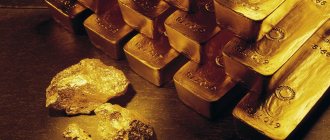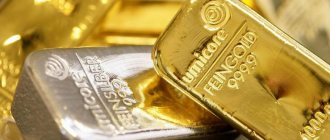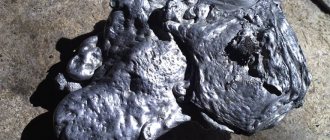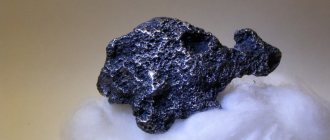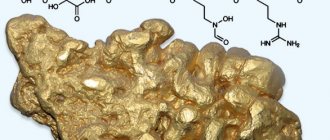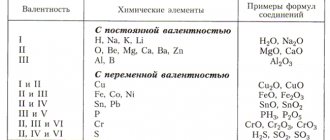Platinum is a very rare metal on Earth, considered precious and malleable for processing. Its name comes from the Spanish language, literally translated as small silver. In the periodic table it appears under the designation Pt. The element is found in nuggets, various alloys and compounds.
Platinum's melting point, heavy weight, hardness and stability in aggressive environments make the metal indispensable in various areas of life.
General characteristics of the metal
Platinum is a noble metal with high density. You can recognize it by its whitish-gray tint and characteristic shine. It does not react to acid, alkali and other elements, which makes it resistant to oxidation and corrosion. The closest neighbors of platinum in the periodic table are iridium, osmium, palladium, rhodium and ruthenium.
The discoverers of platinum were Spanish sailors. Although earlier researchers found artifacts dating back to the times of Ancient Egypt.
When the property of the precious metal to be alloyed with gold was discovered, counterfeit coins and jewelry began to be made in Europe. Yellow metal is also noble and is highly valued, but not as much as platinum.
In nature, platinum is found in admixtures with iron, manganese, nickel and other ores. It can be found in the form of a separate vein or in placers around the mine. There are not so many metal deposits in the world. The main ones are located in South Africa and Russia. There are also deposits in Zimbabwe, Canada, the USA and China.
The precious metal is used in the chemical and industrial sectors, in the automotive industry and astronautics. In medicine, instruments and parts for equipment are made from metal. In addition, platinum molecules have proven themselves in chemotherapy in the treatment of cancer.
Platinum bars
How to care for white gold jewelry
The precious metal alloy does not oxidize. But white gold products attract dust. Connecting with air moisture, it is firmly held on the surface and clogged into the holes. Jewelry should be cleaned once a month.
- Make a solution of regular soap with a minimum amount of additives. “Children’s” and “Household” are best suited.
- Place jewelry in it for a few minutes.
- Remove and wipe with a soft cloth or paper towel.
- The easiest way to clean a textured surface is with a soft-bristled toothbrush.
Jewelry is coated with a thin layer of rhodium during production. It enhances the shine of precious metals. Hard rhodium provides durable protection against scratches and abrasions. Gradually, the protective coating is worn out in places and should be renewed. You won't be able to do this on your own. You should take your jewelry to a jeweler for cleaning.
The microcircuits are wiped with a damp cloth when the equipment is turned off. After this they are dried.
White gold is the name given to various alloys in which alloys are added to the precious metal to whiten it and improve its technical characteristics. The wear resistance of the metal justifies its high cost.
Nuances of processing platinum raw materials
The metal is cleaned of impurities first mechanically, then using chemicals. The latter allows you to improve the quality of the alloy and increase its properties.
Platinum bars are heated in special containers. Aqua regia is also added there. In this way, unnecessary base metals and precipitates containing other elements that cannot be dissolved are separated and dissolved.
The sediment must be filtered and treated with aqua regia. Substances such as osmium and iridium are used for industrial needs, so they are removed from boilers after processing the alloy.
Osmium, palladium and iridium formed during processing must be converted. This is necessary so that ammonium chloride added to the composition cannot affect them, and they do not precipitate. To do this, the solution is changed by heating with sulfuric and oxalic acids.
After ammonium chlorine is introduced, platinum will precipitate in the form of golden granules. It is removed and cleaned with ammonia. The finished product is dried and used for its intended purpose.
Industrial smelting of platinum
Melting methods
When melting precious metals and alloys, it is necessary to create conditions under which their losses are minimized.
Platinum and its alloys are melted in crucible induction furnaces made of calcium oxide, magnesite or zirconium oxide. Melting containers are made of refractory materials. If you need to obtain a product without calcium or magnesium impurities, you can use crucibles made of thorium or zirconium oxides.
Different platinum is used as a raw material for melting: spongy, compressed and in briquettes. You can also use scrap. Additional components are introduced into molten platinum at a temperature of 1850-1900 degrees Celsius. Despite the weak interaction of platinum with furnace gases, smelting must be carried out very quickly, preventing deoxidation of the metal.
Melting platinum at home
Chemical properties
Platinum's chemical properties are similar to palladium, but it exhibits greater chemical stability. Reacts only with hot aqua regia: 3Pt + 4HNO3 + 18HCl = 3H2[PtCl6] + 4NO + 8H2O
Platinum dissolves slowly in hot sulfuric acid and liquid bromine. It does not interact with other mineral and organic acids. When heated, it reacts with alkalis and sodium peroxide, halogens (especially in the presence of alkali metal halides): Pt + 2Cl2 + 2NaCl = Na2[PtCl6]. When heated, platinum reacts with sulfur, selenium, tellurium, carbon and silicon. Like palladium, platinum can dissolve molecular hydrogen, but the volume of absorbed hydrogen is smaller and the ability of platinum to release it when heated is less.
When heated, platinum reacts with oxygen to form volatile oxides. The following platinum oxides are identified: black PtO, brown PtO2, reddish-brown PtO3, as well as Pt2O3 and Pt3O4.
The hydroxides Pt(OH)2 and Pt(OH)4 are known for platinum. They are obtained by alkaline hydrolysis of the corresponding chloroplatinates, for example: Na2PtCl4 + 2NaOH = 4NaCl + Pt(OH)2I, Na2PtCl6 + 4NaOH = 6NaCl + Pt(OH)4I. These hydroxides exhibit amphoteric properties: Pt(OH)2 + 2NaOH = Na2[Pt(OH)4], Pt(OH)2 + 4HCl = H2[PtCl4] + 2H2O, Pt(OH)4 + 6HCl = H2[PtCl6] + 4H2O, Pt(OH)4 + 2NaOH = Na2[Pt(OH)6]. PtF6 hexafluoride is one of the strongest oxidizing agents, capable of oxidizing oxygen, xenon or NO molecules: O2 + PtF6 = O2+[PtF6]-.
With the interaction between Xe and PtF6 discovered by N. Bartlett, leading to the formation of XePtF6, the chemistry of inert gases began. PtF6 is obtained by fluorinating platinum at 1000 °C under pressure. Fluoridation of platinum at normal pressure and temperature 350-400 °C gives Pt(IV) fluoride: Pt + 2F2 = PtF4 Platinum fluorides are hygroscopic and decompose with water. Platinum(IV) tetrachloride with water forms hydrates PtCl4·nH2O, where n = 1, 4, 5 and 7. By dissolving PtCl4 in hydrochloric acid, chloroplatinic acids H[PtCl5] and H2[PtCl6] are obtained. Platinum halides such as PtBr4, PtCl2, PtCl2·2PtCl3, PtBr2 and PtI2 have been synthesized. Platinum is characterized by the formation of complex compounds of the composition [PtX4]2- and [PtX6]2-. While studying platinum complexes, A. Werner formulated the theory of complex compounds and explained the nature of the occurrence of isomers in complex compounds.
Reactivity
Coin 3 rubles, 1834
Platinum is one of the most inert metals. It is insoluble in acids and alkalis, with the exception of aqua regia. Platinum also reacts directly with bromine, dissolving in it.
When heated, platinum becomes more reactive. It reacts with peroxides, and upon contact with atmospheric oxygen, with alkalis. A thin platinum wire burns in fluorine, releasing a large amount of heat. Reactions with other non-metals (chlorine, sulfur, phosphorus) occur less readily. When heated more strongly, platinum reacts with carbon and silicon, forming solid solutions, similar to the iron group metals.
In its compounds, platinum exhibits almost all oxidation states from 0 to +8, of which +2 and +4 are the most stable. Platinum is characterized by the formation of numerous complex compounds, of which many hundreds are known. Many of them bear the names of the chemists who studied them (salts of Cossus, Magnus, Peirone, Zeise, Chugaev, etc.). A great contribution to the study of such compounds was made by the Russian chemist L. A. Chugaev (1873−1922), the first director of the Institute for the Study of Platinum, created in 1918.
Platinum hexafluoride PtF6 is one of the strongest oxidizing agents among all known chemical compounds. With its help, in particular, Canadian chemist Neil Bartlett in 1962 obtained the first true chemical compound of xenon, XePtF6.
Catalyst
Platinum, especially in a finely dispersed state, is a very active catalyst for many chemical reactions, including those used on an industrial scale. For example, platinum catalyzes the reaction of hydrogen addition to aromatic compounds even at room temperature and atmospheric pressure of hydrogen. Back in 1821, the German chemist I. V. Döbereiner discovered that platinum black promotes the occurrence of a number of chemical reactions; however, the platinum itself did not undergo changes. Thus, platinum black oxidized vapors of wine alcohol to acetic acid already at ordinary temperatures. Two years later, Döbereiner discovered the ability of spongy platinum to ignite hydrogen at room temperature. If a mixture of hydrogen and oxygen (explosive gas) is brought into contact with platinum black or spongy platinum, then at first a relatively calm combustion reaction occurs. But since this reaction is accompanied by the release of a large amount of heat, the platinum sponge becomes hot and the explosive gas explodes. Based on his discovery, Döbereiner designed the “hydrogen flint,” a device that was widely used to produce fire before the invention of matches.
Melting temperature
Platinum, as an individual element, has a melting point of 1774 degrees. But this indicator may vary depending on the content of alloys in the alloy. For example:
- platinum alloy with iridium 850/900/950 standard - 1800-1820/1780-1800/1780-1790 degrees;
- platinum alloy with palladium 850/900/950 standard - 1730-1750/1740-1755/1755-1765 degrees;
- alloy with 950 cobalt - 1765-1780 degrees;
- platinum alloy with 950 ruthenium - 1780-1795 degrees.
The melting point of platinum and its other physical characteristics make it possible to use the metal in the production of viscose fiber. Special high-strength molds are made from the alloy, through which plastic material is pressed.
The melting point of the precious metal must be taken into account when introducing alloy components into its composition during the formation of jewelry materials.
Advantages and disadvantages
Just look at diamond jewelry to be convinced that white gold serves as a magnificent setting for them. Jewelry can be worn day or evening.
Yellow gold loses its shine faster. It is softer, constantly scratches and oxidizes over time. In jewelry with diamonds, the yellow metal imparts its hue to them, changing the play of light in the stone. It is superior to alloy when manufactured by casting because it has a relatively low melting point and high ductility.
The cost of platinum and gold is approximately the same. Therefore, precious metals in pure form and alloy are equally expensive. When struck by a hard object they ring melodiously. The sound fades away in waves.
Melting platinum at home
If a situation arises when you need to melt platinum at home, you first need to familiarize yourself with this process. Before the procedure, prepare the necessary tools and materials. Platinum can be melted using homemade gas burners using oxygen cylinders. A welding machine is also used for these purposes. A porcelain crucible is used as a container.
Laboratory porcelain crucible
The mixture is prepared in the same way as in industrial conditions. The melting process itself is performed as follows.
- The platinum alloy is placed in a crucible and heated with a gas burner or other homemade devices until the required temperature is reached.
- The type of metal cast depends on the mold created and personal preference.
- After melting, the platinum must cool completely.
- The finished product is removed from the mold using tools and taking the necessary precautions.
As you can see, you can melt platinum yourself, although the final result largely depends on the skills of the master, the quality of materials and knowledge of technology. It is almost impossible to obtain a pure product without impurities without special equipment, because... All melting methods are not ideal. If you need pure metal, it is better to contact specialists.
